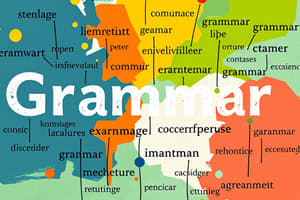Podcast
Questions and Answers
What is the most common sentence structure in English grammar?
What is the most common sentence structure in English grammar?
- Verb-Subject-Object
- Subject-Object-Verb
- Subject-Verb-Object (correct)
- Object-Subject-Verb
Which of the following best describes the function of adverbs in a sentence?
Which of the following best describes the function of adverbs in a sentence?
- Replace nouns
- Modify verbs, adjectives, or other adverbs (correct)
- Connect clauses or sentences
- Identify people, places, or things
Which of the following is NOT a key feature of phonetics and phonology?
Which of the following is NOT a key feature of phonetics and phonology?
- Stress
- Prepositions (correct)
- Phonemes
- Intonation
What is the primary purpose of expository writing?
What is the primary purpose of expository writing?
In the context of vocabulary, what does 'compounding' refer to?
In the context of vocabulary, what does 'compounding' refer to?
Which of the following terms refers to expressions that may not be interpreted literally?
Which of the following terms refers to expressions that may not be interpreted literally?
What is one of the key skills necessary for reading comprehension?
What is one of the key skills necessary for reading comprehension?
What is a major difference between British and American English?
What is a major difference between British and American English?
Flashcards are hidden until you start studying
Study Notes
Overview of the English Language
- Origin: Developed from Germanic languages; influenced by Latin and Norman French.
- Global Use: Widely spoken as a first language and second language worldwide; serves as a global lingua franca.
Phonetics and Phonology
- Phonemes: 44 phonemes (vowels and consonants).
- Stress and Intonation: Key features that affect meaning and clarity.
Grammar
- Parts of Speech:
- Nouns: Names of people, places, things.
- Verbs: Action or state of being.
- Adjectives: Describe nouns.
- Adverbs: Modify verbs, adjectives, or other adverbs.
- Pronouns: Replace nouns.
- Prepositions: Show relationships between nouns/pronouns and other words.
- Conjunctions: Connect clauses or sentences.
- Sentence Structure: Subject-Verb-Object (SVO) is the most common structure.
- Tenses: Present, past, future, along with perfect and continuous aspects.
Vocabulary
- Word Formation:
- Derivation: Adding prefixes/suffixes.
- Compounding: Combining two or more words.
- Synonyms and Antonyms: Key for expanding vocabulary and understanding nuances.
- Idioms and Phrasal Verbs: Common expressions that may not be literal.
Writing
- Types of Writing:
- Expository: Informative or explanatory.
- Descriptive: Details and imagery.
- Persuasive: Argumentative and opinion-based.
- Narrative: Telling a story.
- Structure:
- Introduction, Body, Conclusion.
- Use of paragraphs for organization.
Reading Comprehension
- Skills: Skimming for main ideas, scanning for specific information, inference, and summarization.
- Literary Devices: Metaphor, simile, personification, symbolism, etc.
Dialects and Variants
- British English vs. American English: Differences in spelling, vocabulary, and pronunciation.
- Regional Dialects: Variations within countries, including slang and colloquialisms.
Language Acquisition
- First Language Acquisition: Process by which children learn to speak.
- Second Language Acquisition: Learning another language post-childhood; methods include immersion, direct instruction, and practice.
Cultural Influence
- Literature: Rich tradition from Shakespeare to contemporary authors; reflects societal norms and values.
- Media and Technology: Impact on language evolution, including slang and new vocabulary.
Common Challenges
- Spelling and Pronunciation: Irregularities can create difficulties for learners.
- Grammar Exceptions: Various exceptions to standard grammatical rules.
Assessment
- Standardized Tests: TOEFL, IELTS for proficiency; focus on reading, writing, listening, and speaking skills.
Overview of the English Language
- Originated from Germanic languages, heavily influenced by Latin and Norman French.
- Considered a global lingua franca, facilitating international communication.
Phonetics and Phonology
- Contains 44 distinct phonemes, including various vowel and consonant sounds.
- Stress and intonation patterns play a crucial role in determining meaning and enhancing clarity.
Grammar
- Parts of Speech: Key components include nouns (entities), verbs (actions or states), adjectives (descriptive), adverbs (modifying), pronouns (noun replacements), prepositions (relationships), and conjunctions (connective).
- Sentence Structure: The standard structure is Subject-Verb-Object (SVO).
- Tenses: Varied forms include present, past, and future, incorporating perfect and continuous aspects for nuanced expression.
Vocabulary
- Word Formation: Derived through processes such as adding prefixes/suffixes and compounding multiple words.
- Synonyms and Antonyms: Essential for enhancing vocabulary breadth and understanding subtle distinctions in meaning.
- Idioms and Phrasal Verbs: Frequently utilized expressions whose meanings are often not immediately apparent from their individual components.
Writing
- Types of Writing: Varieties include expository (informative), descriptive (detailed), persuasive (argument-driven), and narrative (storytelling).
- Structure: Writing typically organized into an introduction, body, and conclusion, utilizing paragraphs for clarity and flow.
Reading Comprehension
- Skills: Key techniques include skimming (for main ideas) and scanning (for specific details), as well as inferring meaning and summarizing content.
- Literary Devices: Includes tools like metaphor, simile, personification, and symbolism, enhancing textual depth.
Dialects and Variants
- Differences between British English and American English manifest in spelling, vocabulary, and pronunciation nuances.
- Regional dialects show substantial variation within countries, reflecting local slang and cultural distinctions.
Language Acquisition
- First Language Acquisition: The natural process by which children develop spoken language skills.
- Second Language Acquisition: Involves strategies such as immersion, direct instruction, and practical usage after the critical period of childhood.
Cultural Influence
- English literature spans from Shakespeare to modern writers, depicting cultural values and societal issues.
- Media and technology significantly shape language changes, introducing new slang and expressions.
Common Challenges
- Learners often face difficulties due to irregular spelling and pronunciation patterns.
- Grammar rules have numerous exceptions that can complicate understanding and mastery.
Assessment
- Proficiency tested through standardized exams like TOEFL and IELTS, focusing on four core skills: reading, writing, listening, and speaking.
Studying That Suits You
Use AI to generate personalized quizzes and flashcards to suit your learning preferences.




